Urban Flood Modeling Using 2D Shallow-Water Equations in Ouagadougou, Burkina Faso
Abstract
1. Introduction
2. Materials and Methods
2.1. Study Area
2.2. Two-Dimensional (2D) Flood Inundation Modeling
2.2.1. Mathematical Model Description
- The functions F and G represent the advective and pressure fluxes, respectively, in the x and y directions:
- The terms and designate, respectively, the bottom slope and the friction terms:g [m/s2] represents the gravitational acceleration and [m] define the soil elevation. Friction terms are computed using Manning’s formula [38]:where n [m/s] is the Manning–Strickler coefficient, which characterizes the soil roughness.
- represents the source term stated as:where P [m/s] and I [m/s] are, respectively, the rainfall intensity and infiltration rate. The infiltration rate was estimated using Horton’s model [38]. It is the process of water entrance through the soil profile, and its rate decreases during the rainfall event.where [m/s], [m/s], and r [s] are, respectively, the initial infiltration rate, the final infiltration rate, and a constant depending on soil properties.
2.2.2. Model Numerical Resolution
2.2.3. Grid and Numerical Scheme
- (a)
- In the x-sweeps, we start with a solution along each row of cells , with j fixed. The numerical solution at time is obtained from the resolution of the following scheme:where is an appropriate numerical flux between cells and .
- (b)
- In the y-sweeps, we use the values of as data along each column of cells, with i fixed. That results in the calculation of the solution at time , from the schemewhere is an appropriate numerical flux between cells and .
- (c)
- Friction and source terms (rainfall, infiltration, ...) are taken into account using the two following schemes:
2.2.4. Hydrostatic Reconstruction
- (i)
- The fluxes in the x-axis at the right and left of cell are defined bywhere . The reconstructed solution at the interfaces is defined bywith
- (ii)
- The fluxes in the y-axis above and under cell are defined bywhere . The reconstructed solution at the interfaces is defined bywith
2.2.5. Flux at Cell Interfaces
3. Application to a Peri-Urban Watershed in Ouagadougou
3.1. Model Input Data
3.1.1. Digital Elevation Model or Topographic Data
3.1.2. Roughness and Infiltration Parameters
3.1.3. Rainfall and Water Depth Data
3.2. Model Sensitivity Analysis
- *
- Scenario 1: Sensitivity to rainfall intensity;
- *
- Scenario 2: Sensitivity to Manning’s roughness coefficient;
- *
- Scenario 3: Sensitivity to imperviousness due to urbanization.
3.3. Model Validation
4. Results and Discussion
4.1. Results of the Sensitivity Analysis
4.1.1. Sensitivity Analysis to Rainfall Intensity
4.1.2. Sensitivity Analysis to Manning’s Coefficient
4.1.3. Sensitivity Analysis to Imperviousness Due to Urbanization
4.2. Observed Events Simulation
4.3. Discussion
5. Conclusions
- Flood spatial extent has not been validated because of the lack of field data for that process, and thus, high-resolution aerial photographic data of flood extent for flood map validation deserve to be investigated;
- Sensitivity analysis to digital elevation model resolution for topographic input generation needs to be carried out with a high resolution of 1 m or less to improve accuracy.
Author Contributions
Funding
Acknowledgments
Conflicts of Interest
References
- Di Baldassarre, G.; Montanari, A.; Lins, H.; Koutsoyiannis, D.; Brandimarte, L.; Blöschl, G. Flood fatalities in Africa: From diagnosis to mitigation. Geophys. Res. Lett. 2010, 37. [Google Scholar] [CrossRef]
- Below, R.; Guha-Sapir, D.; Vos, F.; Ponserre, S. Annual Disaster Statistical Review 2010; Centre for Research on the Epidemiology of Disasters: Brussels, Belgium, 2011. [Google Scholar]
- Guha-Sapir, D.; Vos, F.; Below, R.; Ponserre, S. Annual Disaster Statistical Review 2014: The Numbers and Trends; Centre for Research on the Epidemiology of Disasters: Brussels, Belgium, 2015. [Google Scholar]
- CRED. The Human Cost of Natural Disasters: A Global Perspective; Centre for Research on the Epidemiology of Disasters: Brussels, Belgium, 2015. [Google Scholar]
- Erpicum, S.; Dewals, B.; Archambeau, P.; Detrembleur, S.; Pirotton, M. Detailed 2D numerical modeling for flood extension forecasting. In Proceedings of the 4th International Conference on Fluvial Hydraulics: River Flow 2008, Izmir, Turkey, 3–5 September 2008. [Google Scholar]
- Okyere, C.Y.; Yacouba, Y.; Gilgenbach, D. The problem of annual occurrences of floods in Accra: An integration of hydrological, economic and political perspectives. Theor. Empir. Res. Urban Manag. 2013, 8, 45–79. [Google Scholar]
- Petrucci, O.; Aceto, L.; Bianchi, C.; Bigot, V.; Brázdil, R.; Pereira, S.; Kahraman, A.; Kılıç, Ö.; Kotroni, V.; Llasat, M.C.; et al. Flood fatalities in Europe, 1980–2018: Variability, features, and lessons to learn. Water 2019, 11, 1682. [Google Scholar] [CrossRef]
- OCHA. Niger Situation Report; Technical Report; United Nations Office for the Coordination of Humanitarian Affairs: Geneva, Switzerland, 2019. [Google Scholar]
- OCHA. Afrique de l’Ouest Inondations 2009; Technical Report; United Nations Office for the Coordination of Humanitarian Affairs: Geneva, Switzerland, 2009. [Google Scholar]
- Meehl, G.A.; Stocker, T.F.; Collins, W.D.; Friedlingstein, P.; Gaye, T.; Gregory, J.M.; Kitoh, A.; Knutti, R.; Murphy, J.M.; Noda, A.; et al. Global Climate Projections; Cambridge University Press: Cambridge, UK, 2007. [Google Scholar]
- Collins, M.; Knutti, R.; Arblaster, J.; Dufresne, J.L.; Fichefet, T.; Friedlingstein, P.; Gao, X.; Gutowski, W.J.; Johns, T.; Krinner, G.; et al. Long-term climate change: Projections, commitments and irreversibility. In Climate Change 2013-The Physical Science Basis: Contribution of Working Group I to the Fifth Assessment Report of the Intergovernmental Panel on Climate Change; Cambridge University Press: Cambridge, UK, 2013; pp. 1029–1136. [Google Scholar]
- Sylla, M.B.; Nikiema, P.M.; Gibba, P.; Kebe, I.; Klutse, N.A.B. Climate change over West Africa: Recent trends and future projections. In Adaptation to Climate Change and Variability in Rural West Africa; Springer: Berlin/Heidelberg, Germany, 2016; pp. 25–40. [Google Scholar]
- Taylor, C.M.; Belušić, D.; Guichard, F.; Parker, D.J.; Vischel, T.; Bock, O.; Harris, P.P.; Janicot, S.; Klein, C.; Panthou, G. Frequency of extreme Sahelian storms tripled since 1982 in satellite observations. Nature 2017, 544, 475. [Google Scholar] [CrossRef] [PubMed]
- Wilcox, C.; Vischel, T.; Panthou, G.; Bodian, A.; Blanchet, J.; Descroix, L.; Quantin, G.; Cassé, C.; Tanimoun, B.; Kone, S. Trends in hydrological extremes in the Senegal and Niger Rivers. J. Hydrol. 2018, 566, 531–545. [Google Scholar] [CrossRef]
- Klutse, N.A.B.; Ajayi, V.O.; Gbobaniyi, E.O.; Egbebiyi, T.S.; Kouadio, K.; Nkrumah, F.; Quagraine, K.A.; Olusegun, C.; Diasso, U.; Abiodun, B.J.; et al. Potential impact of 1.5 C and 2 C global warming on consecutive dry and wet days over West Africa. Environ. Res. Lett. 2018, 13, 055013. [Google Scholar] [CrossRef]
- Masson-Delmotte, V.; Zhai, P.; Pörtner, H.O.; Roberts, D.; Skea, J.; Shukla, P.; Pirani, A.; Moufouma-Okia, W.; Péan, C.; Pidcock, R.; et al. Global Warming of 1.5 OC: An IPCC Special Report on the Impacts of Global Warming of 1.5 °C Above Pre-industrial Levels and Related Global Greenhouse Gas Emission Pathways, in the Context of Strengthening the Global Response to the Threat of Climate Change, Sustainable Development, and Efforts to Eradicate Poverty; World Meteorological Organization: Geneva, Switzerland, 2018. [Google Scholar]
- OCHA. The Sahel: Converging Challenges, Compounding Risks—A Region under High Pressure; Technical Report; United Nations Office for the Coordination of Humanitarian Affairs: Geneva, Switzerland, 2016. [Google Scholar]
- Shekar, M.; Yazbeck, A.; Hasan, R.; Bakilana, A. Population and Development in the Sahel: Policy Choices to Catalyze a Demographic Dividend; World Bank: Washington, DC, USA, 2016. [Google Scholar]
- Bani, S.S.; Yonkeu, S. Risques d’inondation dans la ville de Ouagadougou: Cartographie des zones à risques et mesures de prévention. J. Ouest-Afr. Des Sci. Gest. 2016, 1, 1–18. [Google Scholar]
- Aich, V.; Koné, B.; Hattermann, F.; Paton, E. Time series analysis of floods across the Niger River Basin. Water 2016, 8, 165. [Google Scholar] [CrossRef]
- Oumarou, H.; Oumarou, A. La Gestion Humanitaire des Inondations dans une Commune de Niamey; International Institute for Environment and Development: London, UK, 2017. [Google Scholar]
- Tarhule, A. Damaging rainfall and flooding: The other Sahel hazards. Clim. Chang. 2005, 72, 355–377. [Google Scholar] [CrossRef]
- Samimi, C.; Fink, A.H.; Paeth, H. The 2007 flood in the Sahel: Causes, characteristics and its presentation in the media and FEWS NET. Nat. Hazards Earth Syst. Sci. 2012, 12, 313–325. [Google Scholar] [CrossRef]
- Tschakert, P.; Sagoe, R.; Ofori-Darko, G.; Codjoe, S.N. Floods in the Sahel: An analysis of anomalies, memory, and anticipatory learning. Clim. Chang. 2010, 103, 471–502. [Google Scholar] [CrossRef]
- Descroix, L.; Guichard, F.; Grippa, M.; Lambert, L.; Panthou, G.; Mahé, G.; Gal, L.; Dardel, C.; Quantin, G.; Kergoat, L.; et al. Evolution of surface hydrology in the Sahelo-Sudanian strip: An updated review. Water 2018, 10, 748. [Google Scholar] [CrossRef]
- Tazen, F.; Diarra, A.; Kabore, R.F.; Ibrahim, B.; Bologo/Traoré, M.; Traoré, K.; Karambiri, H. Trends in flood events and their relationship to extreme rainfall in an urban area of Sahelian West Africa: The case study of Ouagadougou, Burkina Faso. J. Flood Risk Manag. 2019, 12, e12507. [Google Scholar] [CrossRef]
- Schlef, K.E.; Kaboré, L.; Karambiri, H.; Yang, Y.E.; Brown, C.M. Relating perceptions of flood risk and coping ability to mitigation behavior in West Africa: Case study of Burkina Faso. Environ. Sci. Policy 2018, 89, 254–265. [Google Scholar] [CrossRef]
- Soma, A.; Claude, W.; Sampana, L. Gestion des Inondations dans les Villes de Ouagadougou et de Bobo-Dioulasso dans un Contexte Urbain—Entre jeux D’Acteurs et Logiques Territoriales; Technical Report; Overseas Development Institute (ODI): London, UK, 2018. [Google Scholar]
- Garcıa-Navarro, P.; Brufau, P.; Burguete, J.; Murillo, J. The shallow water equations: An example of hyperbolic system. Monogr. Real Acad. Cienc. Zaragoza 2008, 31, 89–119. [Google Scholar]
- Hou, J.; Liang, Q.; Zhang, H.; Hinkelmann, R. An efficient unstructured MUSCL scheme for solving the 2D shallow water equations. Environ. Model. Softw. 2015, 66, 131–152. [Google Scholar] [CrossRef]
- Bates, P.D.; De Roo, A. A simple raster-based model for flood inundation simulation. J. Hydrol. 2000, 236, 54–77. [Google Scholar] [CrossRef]
- Mignot, E.; Paquier, A.; Haider, S. Modeling floods in a dense urban area using 2D shallow water equations. J. Hydrol. 2006, 327, 186–199. [Google Scholar] [CrossRef]
- Paquier, A.; Mignot, E.; Bazin, P.H. From hydraulic modelling to urban flood risk. Procedia Eng. 2015, 115, 37–44. [Google Scholar] [CrossRef]
- Abily, M.; Bertrand, N.; Delestre, O.; Gourbesville, P.; Richet, Y.; Duluc, C.M. Global sensitivity analysis with 2d hydraulic codes: Applied protocol and practical tool. La Houille Blanche 2015, 16–22. [Google Scholar] [CrossRef]
- Abily, M.; Delestre, O.; Gourbesville, P.; Bertrand, N.; Duluc, C.M.; Richet, Y. Global sensitivity analysis with 2D hydraulic codes: Application on uncertainties related to high-resolution topographic data. In Advances in Hydroinformatics; Springer: Berlin/Heidelberg, Germany, 2016; pp. 301–315. [Google Scholar]
- Alcrudo, F. A State of the Art Review on Mathematical Modelling of Flood Propagation; First IMPACT Project Workshop: Wallingford, UK, 2002; Available online: http://www.impact-project.net/cd/papers/print/008_pr_02-05-16_IMPACT_Alcrudo.pdf (accessed on 24 July 2020).
- Nkwunonwo, U.; Whitworth, M.; Baily, B. A review of the current status of flood modelling for urban flood risk management in the developing countries. Sci. Afr. 2020, 7, e00269. [Google Scholar] [CrossRef]
- Maugeri, A. Capabilities of a Coupled 1D/2D Model for Flood Inundation Simulation; Columbia Water Center: New York, NY, USA, 2012. [Google Scholar]
- Fan, Y.; Ao, T.; Yu, H.; Huang, G.; Li, X. A coupled 1D-2D hydrodynamic model for urban flood inundation. Adv. Meteorol. 2017, 2017, 2819308. [Google Scholar] [CrossRef]
- Anees, M.T.; Abdullah, K.; Nordin, M.N.M.; Ab Rahman, N.N.N.; Syakir, M.I.; Kadir, M.O.A. One-and Two-Dimensional Hydrological Modelling and Their Uncertainties. Flood Risk Manag. 2017, 11, 221–244. [Google Scholar]
- Nanía, L.S.; León, A.S.; García, M.H. Hydrologic-hydraulic model for simulating dual drainage and flooding in urban areas: Application to a catchment in the metropolitan area of Chicago. J. Hydrol. Eng. 2015, 20, 04014071. [Google Scholar] [CrossRef]
- Bellos, V.; Tsakiris, G. A hybrid method for flood simulation in small catchments combining hydrodynamic and hydrological techniques. J. Hydrol. 2016, 540, 331–339. [Google Scholar] [CrossRef]
- Nguyen, P.; Thorstensen, A.; Sorooshian, S.; Hsu, K.; AghaKouchak, A.; Sanders, B.; Koren, V.; Cui, Z.; Smith, M. A high resolution coupled hydrologic–hydraulic model (HiResFlood-UCI) for flash flood modeling. J. Hydrol. 2016, 541, 401–420. [Google Scholar] [CrossRef]
- Audusse, E.; Bouchut, F.; Bristeau, M.O.; Klein, R.; Perthame, B.t. A fast and stable well-balanced scheme with hydrostatic reconstruction for shallow water flows. SIAM J. Sci. Comput. 2004, 25, 2050–2065. [Google Scholar] [CrossRef]
- Buffard, T.; Gallouet, T.; Hérard, J.M. Un schéma simple pour les équations de Saint-Venant. C. R. Acad. Des. Sci. Paris Ser. 1998, 326, 385–390. [Google Scholar] [CrossRef]
- Fraga, I.; Cea, L.; Puertas, J. Validation of a 1D-2D dual drainage model under unsteady part-full and surcharged sewer conditions. Urban Water J. 2017, 14, 74–84. [Google Scholar] [CrossRef]
- Toro, E.F. The HLL and HLLC Riemann solvers. In Riemann Solvers and Numerical Methods for Fluid Dynamics; Springer: Berlin/Heidelberg, Germany, 2009; pp. 315–344. [Google Scholar]
- Sanders, B.F.; Bradford, S.F. Network implementation of the two-component pressure approach for transient flow in storm sewers. J. Hydraul. Eng. 2011, 137, 158–172. [Google Scholar] [CrossRef]
- Deng, X.; Boivin, P.; Xiao, F. A new formulation for two-wave Riemann solver accurate at contact interfaces. Phys. Fluids 2019, 31, 046102. [Google Scholar] [CrossRef]
- Arcement, G.J.; Schneider, V.R. Guide for Selecting Manning’s Roughness Coefficients for Natural Channels and Flood Plains; US Geological Survey: Reston, VA, USA, 1989.
- Musy, A.; Higy, C. Hydrologie Appliquée Technical Report. Edition HGA, Bucarest. 1998. Available online: https://hydrologie.org/BIB/manuels/Musy1-HGA.pdf (accessed on 24 July 2020).
- Pit, R.; Lantrip, J.; Harrison, R.; Henry, C.L.; Xue, D. Infiltration through Disturbed Urban Soils and Compost-Amended Soil Effects on Runoff Quality and Quantity; National Risk Management Research Laboratory: Duluth, GA, USA, 1999.
- Hingray, B.; Picouet, C.; Musy, A. Hydrologie: Tome 2, Une Science Pour l’ingénieur; PPUR Presses Polytechniques: Lausanne, Switzerland, 2009; Volume 21. [Google Scholar]
- Kumar, M. Sensitivity analysis of Manning’s roughness coefficient in MIKE 11 model for Mahanadi delta region. Ann. Plant Soil Res. 2019, 21, 62–66. [Google Scholar]
- Nash, J.A.J.V. River flow forecasting through conceptual models, I: A discussion of principles. J. Hydrol. 1970, 10, 398–409. [Google Scholar] [CrossRef]
- Bellos, V.; Tsakiris, G. Comparing various methods of building representation for 2D flood modelling in built-up areas. Water Resour. Manag. 2015, 29, 379–397. [Google Scholar] [CrossRef]
- Laouacheria, F.; Kechida, S.; Chabi, M. Modelling the impact of design rainfall on the urban drainage system by Storm Water Management Model. J. Water Land Dev. 2019, 40, 119–125. [Google Scholar] [CrossRef]
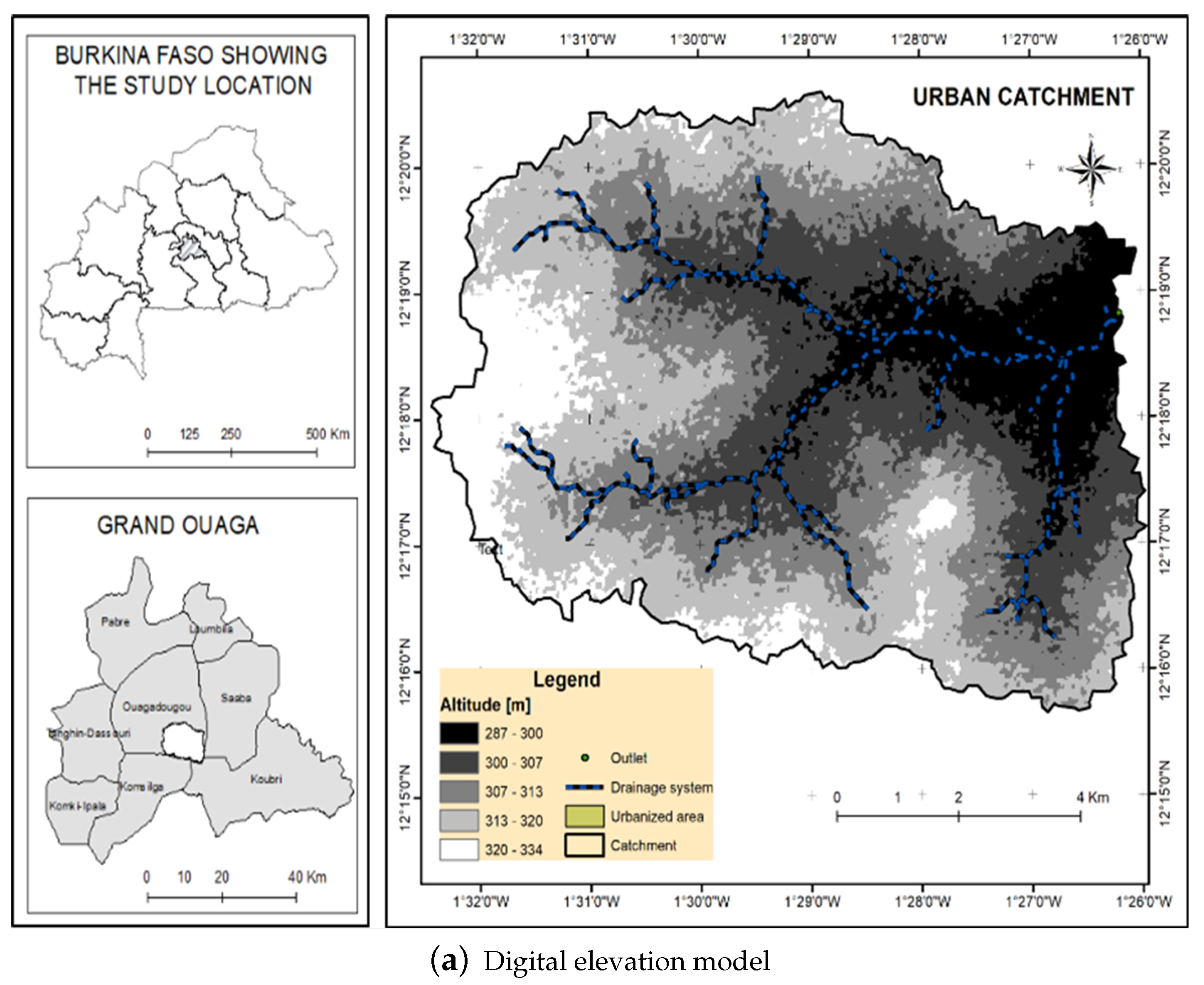



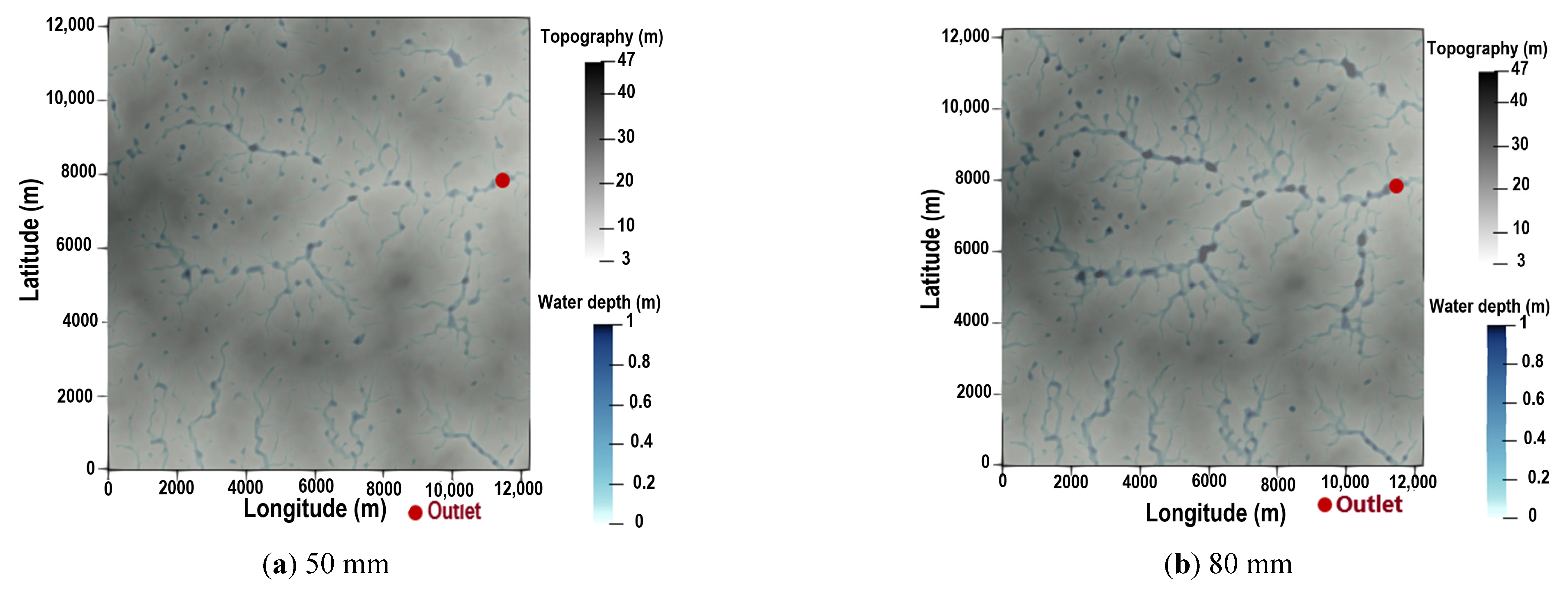
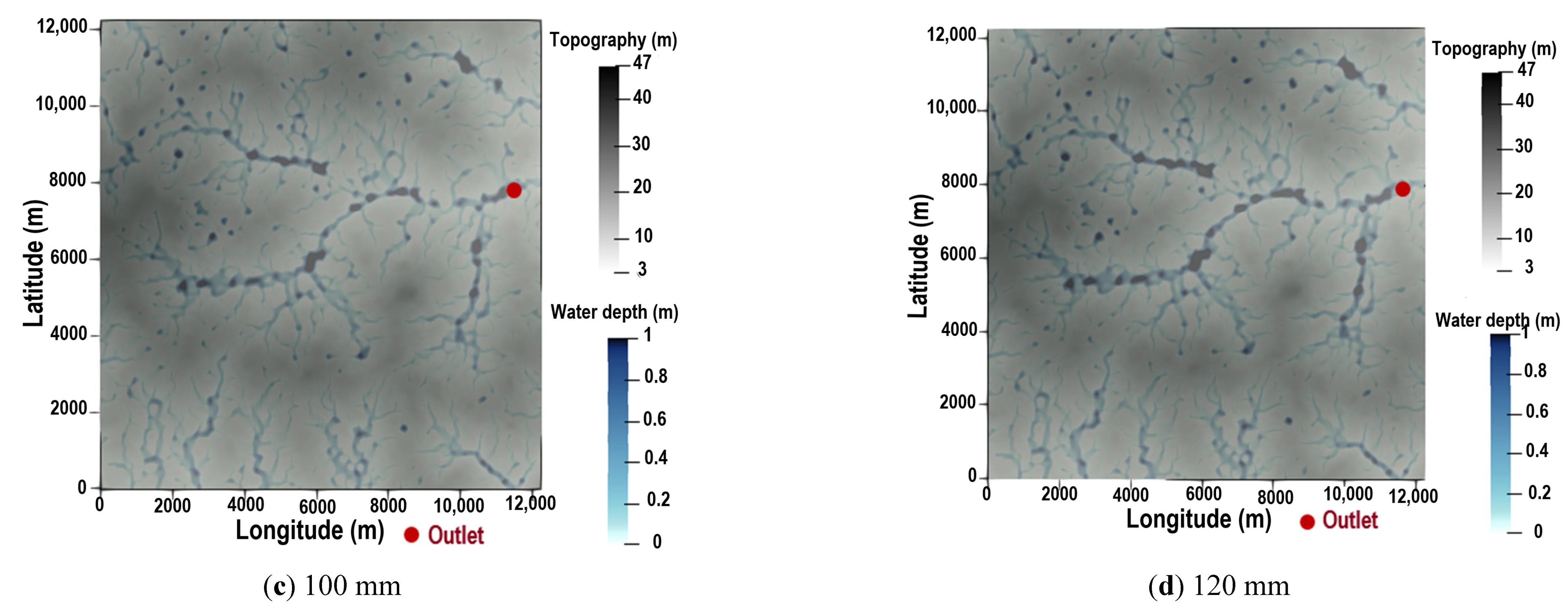
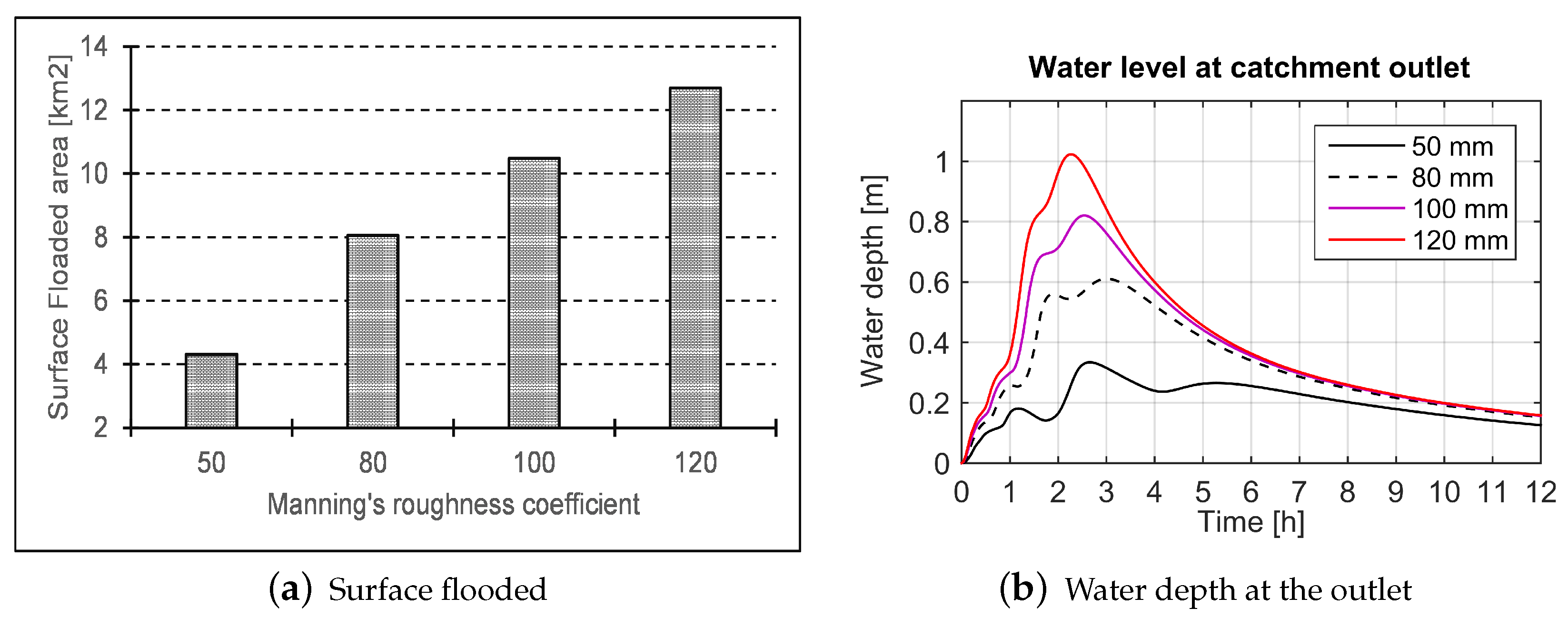
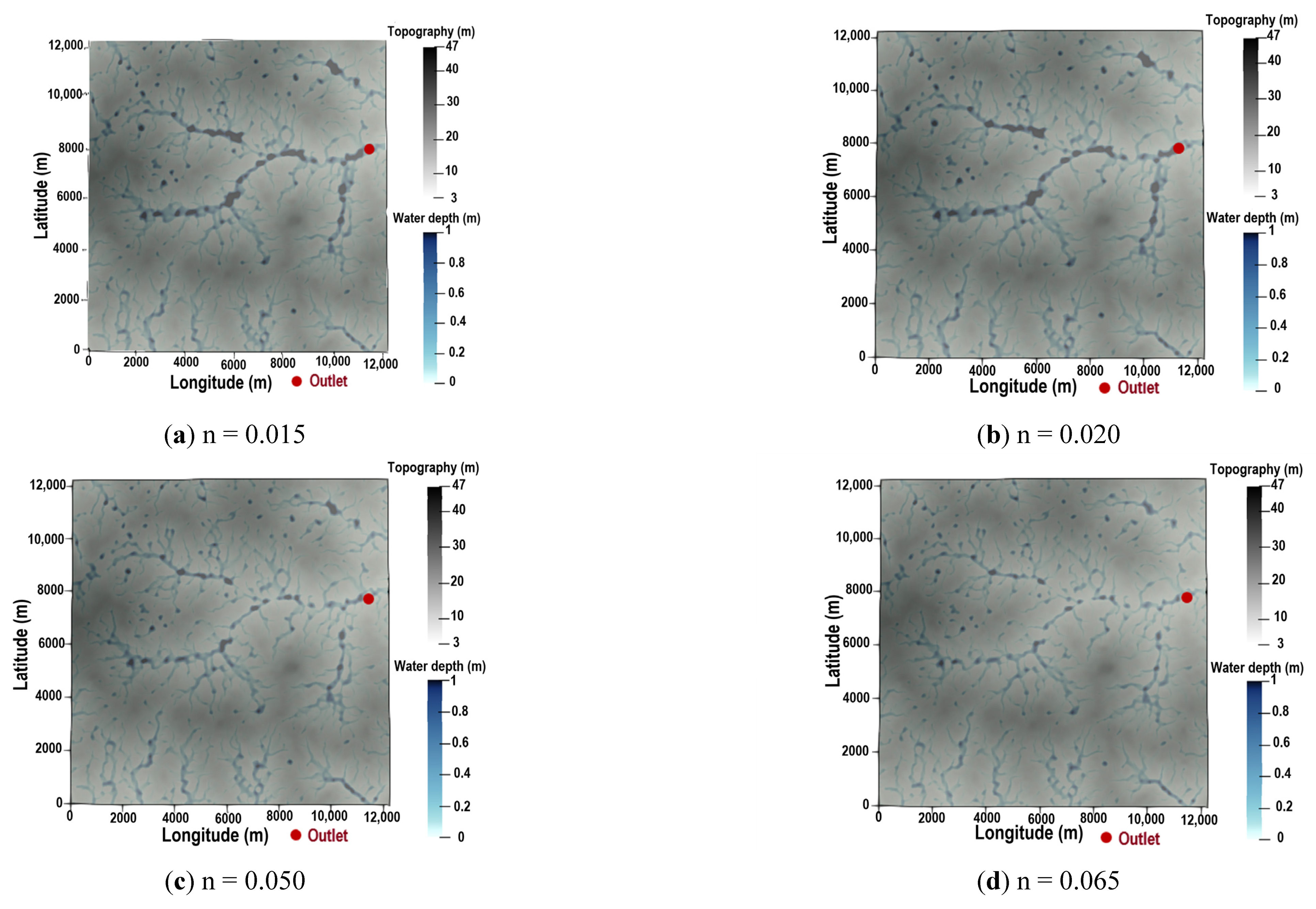


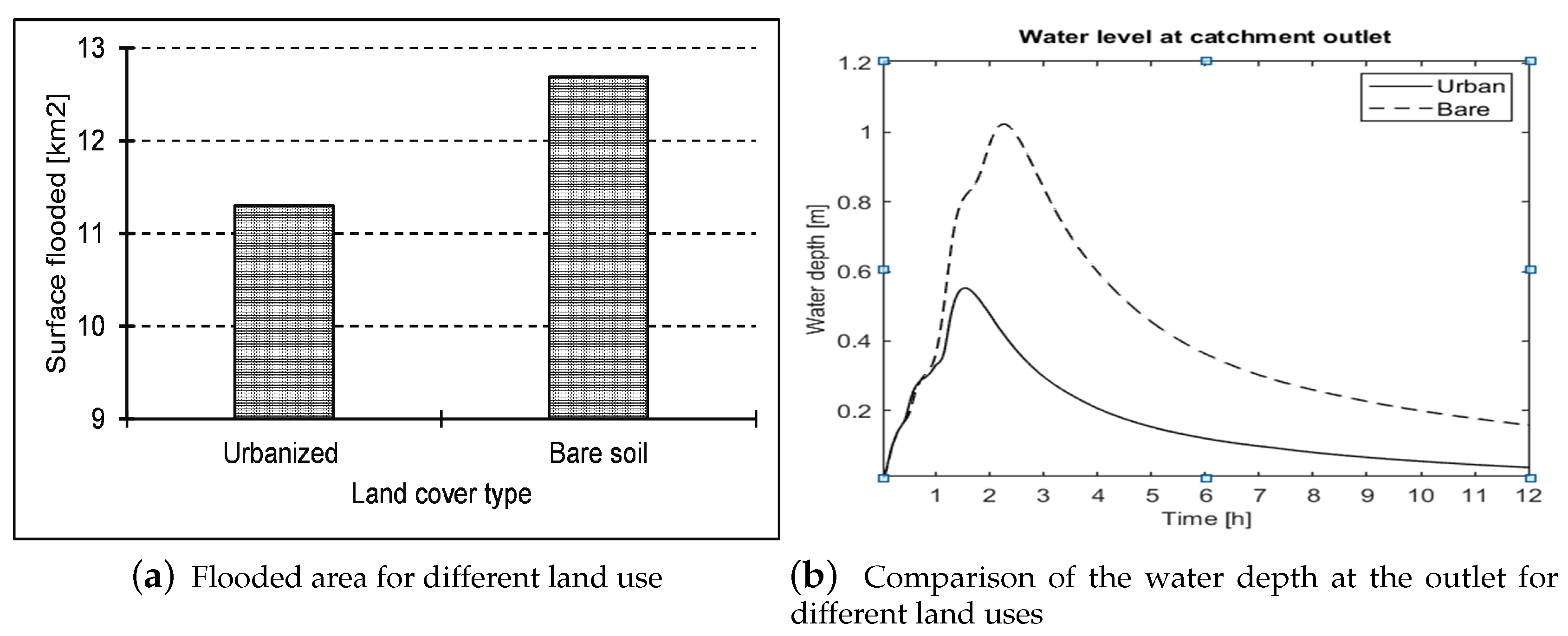
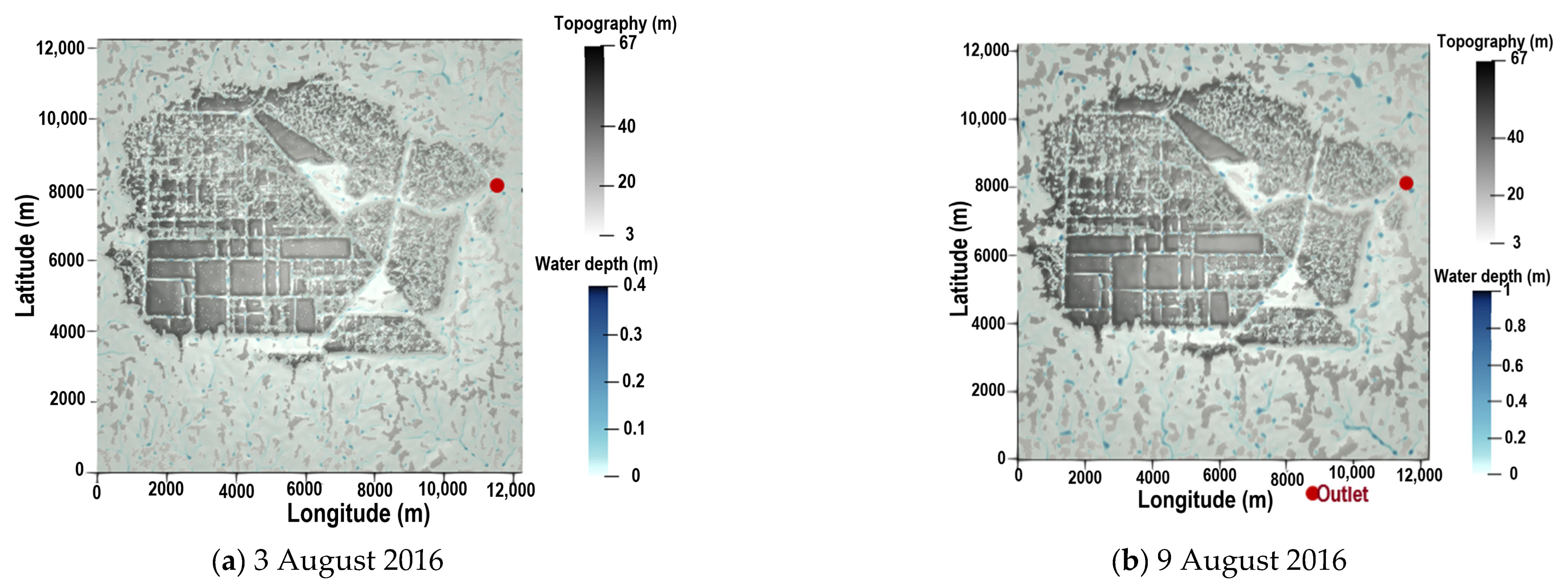
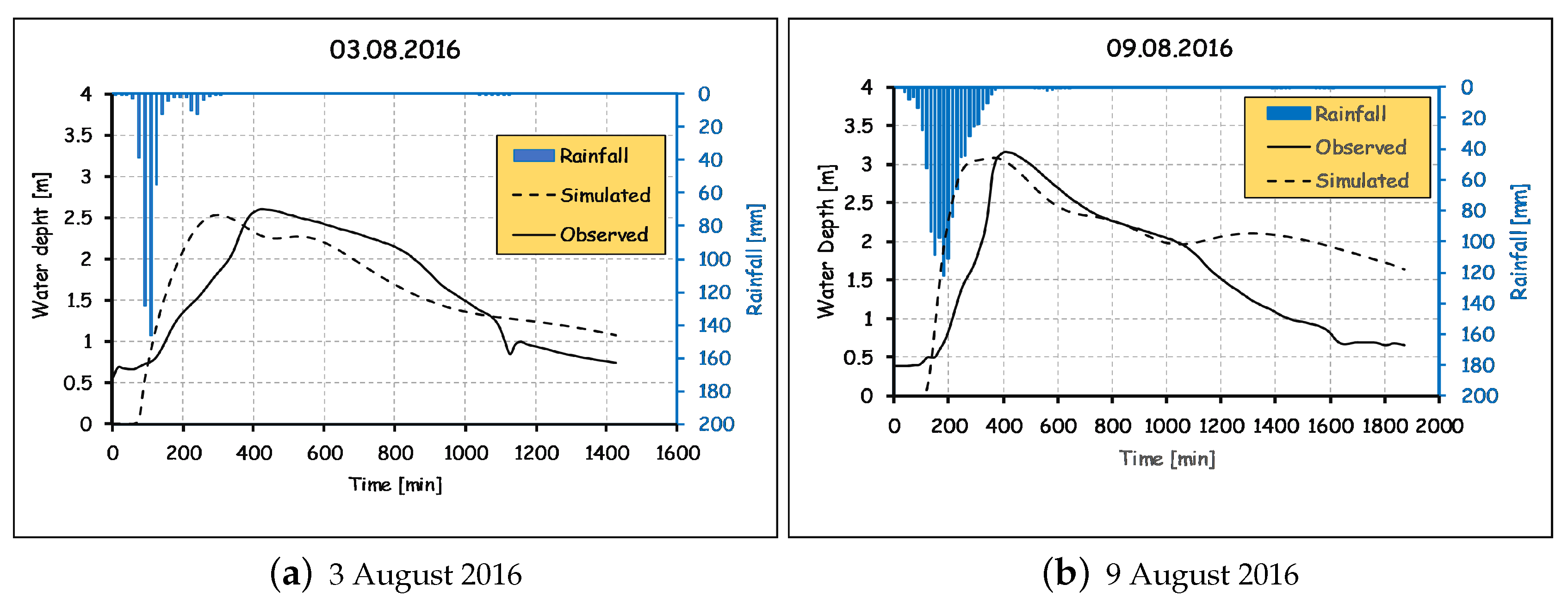
| Land Cover | Vegetated | Bare | Cultivated | Urban |
|---|---|---|---|---|
| n [m] | 0.065 | 0.020 | 0.050 | 0.015 |
| Land Cover | Vegetated | Bare | Cultivated | Urban |
|---|---|---|---|---|
| [mm/s]* | 0.029 | 0.005 | 0.021 | 0.003 |
| [mm/s]* | 0.097 | 0.017 | 0.069 | 0.008 |
| r [1/s]* | 1.383 | 1.383 | 1.383 | 1.383 |
| Rainfall [mm/hr] | [mm/s]* | [mm/s]* | r [1/s]* | n [m] |
|---|---|---|---|---|
| 50 | 0.005 | 0.017 | 1.383 | 0.020 |
| 80 | 0.005 | 0.017 | 1.383 | 0.020 |
| 100 | 0.005 | 0.017 | 1.383 | 0.020 |
| 120 | 0.005 | 0.017 | 1.383 | 0.020 |
| Land Cover | n [m] | [mm/s]* | [mm/s]* | r [1/s]* | Rainfall [mm/hr] |
|---|---|---|---|---|---|
| Vegetated | 0.065 | 0.029 | 0.097 | 1.383 | 120 |
| Bare | 0.020 | 0.005 | 0.017 | 1.383 | 120 |
| Cultivated | 0.050 | 0.021 | 0.069 | 1.383 | 120 |
| Urban | 0.015 | 0.003 | 0.008 | 1.383 | 120 |
| Land Cover | [mm/s]* | [mm/s]* | r [1/s]* | n [m] | Rainfall [mm/hr] |
|---|---|---|---|---|---|
| Bare | 0.005 | 0.017 | 1.383 | 0.02 | 120 |
| Urbanized | 0.003 | 0.008 | 1.383 | 0.015 | 120 |
© 2020 by the authors. Licensee MDPI, Basel, Switzerland. This article is an open access article distributed under the terms and conditions of the Creative Commons Attribution (CC BY) license (http://creativecommons.org/licenses/by/4.0/).
Share and Cite
Coulibaly, G.; Leye, B.; Tazen, F.; Mounirou, L.A.; Karambiri, H. Urban Flood Modeling Using 2D Shallow-Water Equations in Ouagadougou, Burkina Faso. Water 2020, 12, 2120. https://doi.org/10.3390/w12082120
Coulibaly G, Leye B, Tazen F, Mounirou LA, Karambiri H. Urban Flood Modeling Using 2D Shallow-Water Equations in Ouagadougou, Burkina Faso. Water. 2020; 12(8):2120. https://doi.org/10.3390/w12082120
Chicago/Turabian StyleCoulibaly, Gnenakantanhan, Babacar Leye, Fowe Tazen, Lawani Adjadi Mounirou, and Harouna Karambiri. 2020. "Urban Flood Modeling Using 2D Shallow-Water Equations in Ouagadougou, Burkina Faso" Water 12, no. 8: 2120. https://doi.org/10.3390/w12082120
APA StyleCoulibaly, G., Leye, B., Tazen, F., Mounirou, L. A., & Karambiri, H. (2020). Urban Flood Modeling Using 2D Shallow-Water Equations in Ouagadougou, Burkina Faso. Water, 12(8), 2120. https://doi.org/10.3390/w12082120






